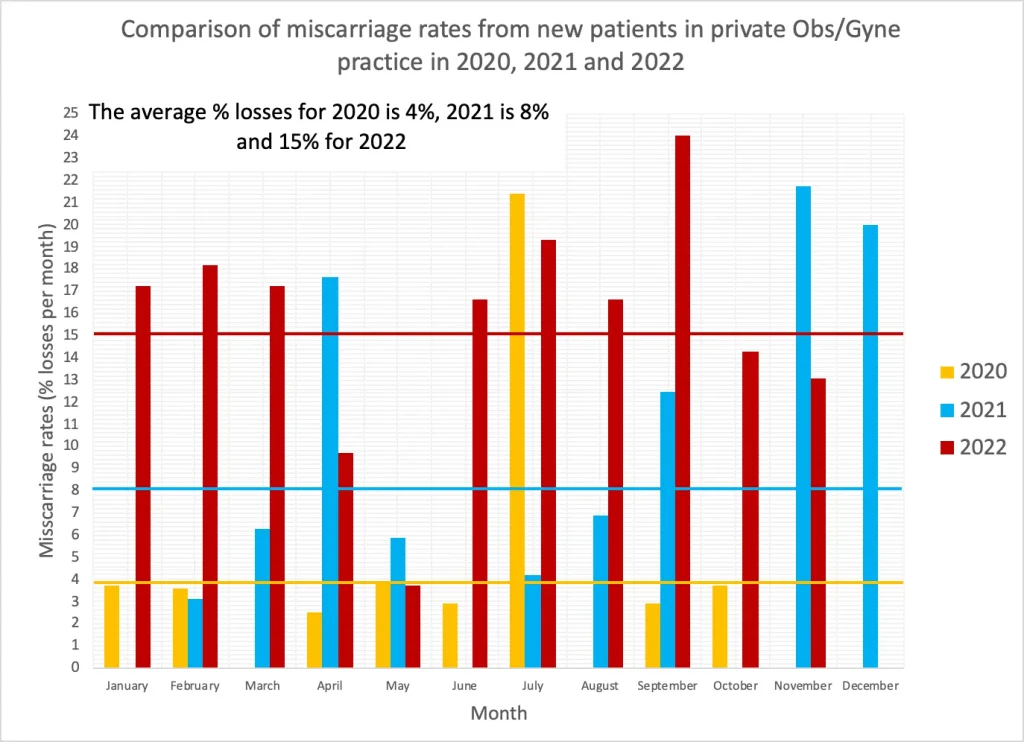Real Time Obstetrician/Gynecologist’s Data on New Patients and Miscarriages for 2021 and 2022 (and now 2020 for baseline)

Direct from the horse’s mouth…
My contact is providing details on 2020 data. Here’s one additional plot.

Here’s some monthly data for 2020 for now. Let me know what else you want to see (Joel). 🙂 I am double checking if that July 2020 data point is correct. It looks weird. I checked and it’s a real point. Just anomalous.

I have been contacted by an obstetrician/gynecologist with some data they had been collecting for the past 2 years as part of their sacred duty in their practice. This person collected new patient data and miscarriage data and also has average rates for the past years.
This is what the data looks like.
First is a chart showing new patients per month for 2021 and 2022 when compared to the average number of new patients in 2020 which was between 32 and 40. For each month in both 2021 and 2022, the number of new patients falls below the average.1
UPDATE: New patient data with 2020 for baseline.


Figure 1: New patient data from an Obstetrician/Gynecologists’s office for 2021 and 2022.
Now perhaps it could also be that women are choosing not to get pregnant because psychopaths are trying to make the world explode, but if that’s the case, then why are we seeing more miscarriages as well as shown in Figure 2?
Update: Miscarriages absolute counts with 2020 data for background.

The numbers of miscarriages are higher for each month except for November 2021 (we don’t have December data yet). The numbers are the same for April and May. Now these miscarriage numbers are the numbers of miscarriages per number of new patients per month so when we plot the rates, it becomes abundantly clear that the miscarriage rates are twice that in 2022 than they were for 2021 as shown in Figure 3 on average.

If we only look at the December 2021 miscarriage rate and compare it to the 2022 rates, we get a clearer picture of what the miscarriage rates have been since the COVID-19 injectable products have been rolled out in the U.S. when compared to the average for 2021 (excluding December).

So with just a few points of data, we get an unbiased assessment of the change in miscarriage rates in 2021 and 2022. It is pretty clear from this data that, for some reason, there are more miscarriages and fewer new moms to begin with in 2022.
Perhaps the most concise way to show the difference between 2021 and 2022 is by showing the cumulative losses (miscarriages) against the cumulative losses over cumulative new patients as shown in Figure 5.

By the way, I thought it appropriate to show everyone the current (09.09.22; 07.14.22; 10.27.22) product monographs with regard to the safety and efficacy of the Pfizer, Moderna and Janssen products in pregnant women. Oh and don’t forget to register your data to the snake pit. You cannot make this shit up.

This article was republished from the author’s Substack.
One of our country’s most important freedoms is that of free speech.
Agree with this essay? Disagree? Join the debate by writing to DailyClout HERE.





I think the reason for the increase in April, 2021 is that the first round of the jabs was widely available in March-April so we could be seeing the initial impact. There is a hypothesis that the first round was more deleterious but I don’t have data to support that.